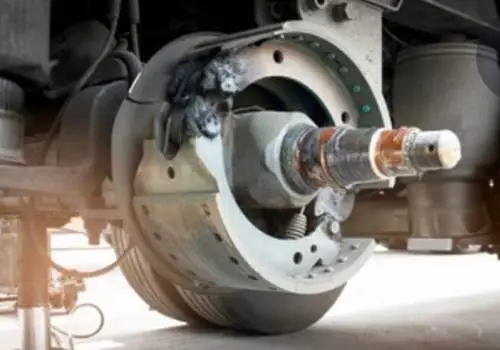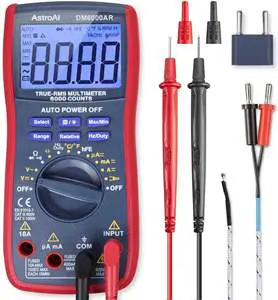
If you are a trailer owner or have a similar vehicle like a caravan, RV, or consumer-grade car, you might be familiar with electric brakes.
These are brakes controlled by a system that runs on electric current and are often a part of medium-duty vehicles.
Now even though it’s a handy piece of equipment, it does become faulty at times. The reason can be over time wear and tear or some fault that occurs in the system.
How to Test Electric Trailer Brakes without Truck?
I have seen people on the internet searching for ways to test electric brakes for trailers without a truck, but there isn’t any satisfactory enough answer, so here is an easy and quick way:
For this purpose, you’ll need a 12v battery and a compass. To test the electric trailer brakes without a truck, start by giving the brakes some power through the 12v battery. Place the compass near the brake drum and notice the movement of the needles. If there is some movement in the compass’s hands, everything is A-Okay. If not, there’s an issue.
How can you beat that?
To fix it, you’ll have to dig in deeper and check the magnets for any fault of wear and tear.
Most of the time, the major problem is rusting or other kinds of deposition on the drum area. Get a suitable cleaning agent that also removes rust, and your brake drums should be all better.
You can also try and pull the breakaway switch. If it doesn’t lock up the trailer instantly, that can be the problem too.
Remember, if adjusting doesn’t rectify the situation, you will have to disassemble the mechanism, for which I always recommend taking professional help.
How to Test Trailer Brakes with a Multimeter?
Start by selecting an ohmmeter and note down the resistance between the wires of the brake magnets. If you find the resistance, not between the specified range, the magnets require immediate replacement. Refer to the table below for these ranges:
| Diameter of the brake magnet | Resistance |
| 7 inches | 3.8-4.0 Ohms |
| 10 and 12 inches | 3.2-3.5 Ohms |
The multimeter method is comparatively more straightforward to follow. Having a multimeter is quite helpful if you own a trailer. Don’t have a multimeter? You can buy it right now from Amazon. See Price.
How to Test Trailer Brake Wiring?
For testing the trailer brake wiring, the vehicle must be lifted. Get your jack and jack stand out.
Jack up the wheel. Spin the wheel manually and apply the brakes. Doing so should result in the wheel stopping immediately. If one of the wheels abruptly stops spinning, that means there is current which means it’s reasonable to assume the brake wiring is fine.
However, if you doubt, you can repeat the process as mentioned above to make sure.
Do not miss these Helpful tips!!!
Use a multimeter or an LED bulb to get voltage and identify a fault in the wiring. The continuity option will help you find breakage in the wire(s).
On a 7-pin conductor, there are some things that you need to observe. Each color represents a different condition.
- White (neutral) no voltage
- Blue (brake output) should vary from 0 – 12VDC based on preset and as you operate the brake controller manual operator
- Green (running lights) should be on 12VDC when lights are on
- Black (battery +) 12VDC should charge your TT battery when connected to the RV/TV
- Red (left turn/stop) should light (blink) when your left turn signal is on
- Brown (right turn/stop) should light (blink) when your right turn signal is on
- Yellow (center pin) typically not used
How to Test Electric Trailer Brakes with Battery?
There is a short and quick way of testing electric trailer brakes, and all you need is a battery. Yes, you read that right!
Spin the wheel and take a fully charged 12V battery and apply direct power to the electric trailer brakes. Put on the power directly on the ground contacts and the hot on the trailer’s plug, or you can also try doing so to the two wires of the individual brake assembly.
If the wheel stops spinning then the brakes are working fine moreover you can also hear the sound of engaging brake drums.
What are the Common Problems Electric Trailer Brakes have?
There are so many problems that might hinder the performance of electric trailer brakes, like too small or large enough gauge wires, connectors, bad brake controller, bad magnets or coil, etc. Following are some of the most occurring problems in electric trailer brakes:
Brake Controller Malfunctioning
Sometimes, the brake controller stays on or won’t go off. These problems occur primarily because of corrosion of regular wear and tear in the brake controller system.
Battery Problems
Low voltage in the battery can also lead to electric brakes malfunctioning because the insufficient charge doesn’t get it running the way it should.
Wear and Tear of Magnets
Electric brake magnets tend to get worn out just like any other part of the vehicle. There are some visible signs of worn-out magnets like exposed windings for you to identify quickly.
Coil Resistance
If the coil is offering too high resistance, the power dissipation would be low, and the vehicle would cause slowdowns very slowly.
However, if the resistance is too low, the vehicle would decelerate faster, yet it will negatively affect the mechanism of the controller.
TV to TT connector
It can be a problem if the contacts of Tv to TT connectors go bad. In such a case, the electric brakes might end up malfunctioning.
Curious about Testing Trailer Brakes at Plug, let’s find out
Before getting into the whole testing maneuver, you first need to develop a deeper understanding of the structure and know what you’ll deal with.
Since we are using a 7-pin plug, let’s keep it simple.
| Pins | Function |
| Right pin Left pin Bottom pin Top-left pin Top-right pin Bottom-left Bottom-right | Right signal+ right brake lights Left signal+ left brake lights Brake pedal Running lights Constant power (black wire) Neutral wire Electric brake |
To test the trailer brakes at the plug, place one lead of voltmeter on the neutral (bottom left pin) and constant power (top-right pin). If you get 12V, all’s good. To test the signal lights, place one lead on the right pin while keeping the other neutral.
You can test all the connections of the 7-pin plug through this method by placing one lead on neutral and the other on the point you want to try.
How do I know if My Brake Controller is Bad?
If your brake controller has become faulty, there will be some prominent symptoms that you can quickly identify.
One way is to drive on loose gravel or dirt-covered ground at 10 MPH, applying 100% braking to the trailer using the brake controller. If your wheels lock up, there is no issue but, if you feel like they are even a little bit lost, there is another way to fix that.
Try adjusting them manually and run the test one more time. Check the user manual to understand the controller of your trailer better.
Here is the thing, some controllers require trailer-specific calibration; only then they do start working fine.
How do You Test an Electric Brake Controller without a Trailer?
Remember, we are dealing with trailer brake controller troubleshooting here, so the wiring must be proper.
The curbside will have a 12v power, brake and turn signal, and then the electric brake signal line pin. Now that you have located all the essential points let’s get started.
Begin by checking the voltage by placing the voltage tester’s pin on the point you think is a brake control. Find some for manually activating the brake control with the bit of lever there. Since you are at it, it’s better to check the connections for the turn signal too.
Now, not all of us have a voltage tester lying around. Don’t worry. I have just the alternative for you. Use a 12 v LED bulb between the ground and brake signal pins.
This method will also help you determine if the brake control is functional or not.
What is Trailer Brake Controller Output Voltage?
As the brake controller is receiving power from the battery of the TV, that is 12 V, so it will also provide 12 V on the output, if set to the maximum gain.
Related Article: Do I Need a Trailer Brake Controller

